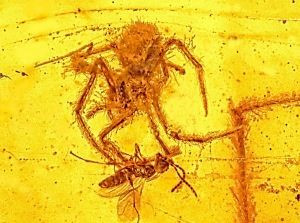Fossilized Spider Attack Is 100 Million Years in the Making

A spider has been waiting for its meal for 100 million years. A one-of-a-kind fossil has been discovered by researchers at Oregon State University. The fossil captures a spider in the midst of capturing its prey, a parasitic wasp.
"The extraordinarily rare fossils are in a piece of amber that preserved this event in remarkable detail an action that took place in the Hukawng Valley of Myanmar in the Early Cretaceous between 97 [to] 110 million years ago, almost certainly with dinosaurs wandering nearby, "a press release issued by the school said.
George Poinar, Jr. recorded the find in the journal Historical Biology. He is the school's preeminent paleo-entomologist. He describes the scene as a male wasp who had found himself in his most terrifying situation - trapped in a web. The juvenile spider was going to make a meal of him, but never quite got to it, and the moment has been recorded in eternity. "This was the wasp's worst nightmare, and it never ended," Poinar said.
Poinar says that the spider was inspecting its meal when tree resin washed over them, capturing them forever.
Also in the amber fossil was another spider on the web, which indicates that arachnids were social as far as back as 100 million years prior to today. There were also 15 strands of intact silk encased in the fossil.
The time period would have meant that the attack would have occurred while dinosaurs roamed the earth. The species of both the spider and the wasp are now extinct.
But in the wasp's case at least, its descendants are still around. "This type of wasp...belongs to a group that is known today to parasitize spider and insect eggs," the release said. "In that context, the attack by the spider, an orb-weaver, might be considered payback."
The interaction recorded in amber is probably a reminder for every child to quit playing with his or her food.



























